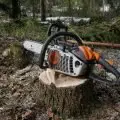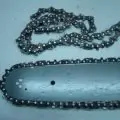Chainsaw blades and chains specifically come in a plethora of different types. Unique chainsaw chain types are produced by varying pitch and gauge, cutter style, chain arrangement, and cutter material. Each type of chainsaw chain has distinctive cutting qualities and is appropriate for various chainsaws and user abilities.
What could be more detrimental than picking the incorrect chainsaw for the task? Choosing the incorrect chainsaw chains. But navigating through the various chainsaw chain types that are available can be challenging. Who knows what the differences between chainsaw chains are? And what benefits does each hold over the other?
In this article, we present all the relevant information on the types of chainsaw chains, including their pitch and gauge, cutter style, chain arrangement, and cutter material, so that you can choose the right one for you.
Table of Contents
- Chainsaw Chain Pitch and Gauge
- Chainsaw Chain Gauge
- Length of the Chainsaw Guide Bar
- Different Types of Chainsaw Chains
- FAQs (Frequently Asked Questions)
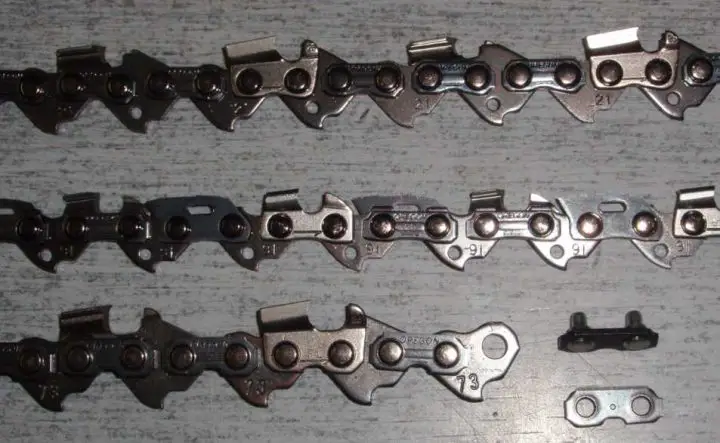
Chainsaw Chain Pitch and Gauge
Depending on your degree of expertise and the kinds of projects you want to use the chainsaw for, you can choose some chainsaw chain aspects. The exact chainsaw you have determines additional factors. There are several variations in chainsaw chains across the board, and there are no chains that fit all chainsaws.
Your chainsaw determines the “pitch,” “gauge,” and, to some extent, the length of the bar. These features of a chain saw chain cannot be chosen. The chain saw chain’s gauge and pitch are crucial compatibility factors. There aren’t any universal chainsaw chains because of this.
Make sure the chain saw chain will fit into the component that drives the chain around the guide bar before making your selection. The guide bar will lock up and the chain will jam up if the chainsaw chain does not match the chainsaw’s settings.
The pitch and gauge of your chainsaw should be marked on the tool or in the owner’s manual, according to the manufacturer’s specifications. You will normally find this information on a label under the handle.
Interested in the history of chainsaws? Have a read here!
Chainsaw Chain Pitch
There are several different pitch sizes for chain saw chains. The spacing between the drive links is known as the pitch of a chain. As you know by now, the pitch of your chainsaw chain is a crucial compatibility factor. The chain’s pitch, the guide bar’s pitch, and the chainsaw drive sprocket’s pitch must all be the same. Typically, your machine will have a label indicating the chainsaw pitch compatibility, or the manual will provide the information.
You can use this knowledge to ensure that the chainsaw you buy has the pitch you require if you are purchasing a new chainsaw. Larger pitch sizes typically equate to larger, heavier chainsaw chains.
Here is a quick guide to determining which size is right for your project:
- 1/4″
- Pixel 3/8″ Mini
- 3/8″ Mini
- Pixel .325″
- .325″
- 3/8″
- .404″
1/4″ Pitch
For chainsaws with engines up to 38cc, 1/4-inch pitch chainsaw chains are advised. They are incredibly light and will support you in making precise and clean cuts.
Pixel 3/8″ Mini Pitch
Low kickback and minimal weight characterize the Pixel 3/8″ mini chainsaw blades. They are advised for battery-powered chainsaws because they use less energy.
3/8″ Mini Pitch
For use with smaller chainsaws, there are 3/8′′ mini chainsaw chains. They are employed by woodcutters in a setting with high output. However, you cannot use these chains on chainsaws with an engine size greater than 45 cc.
Pixel .325″ Pitch
Pixel .325-inch chainsaw chains should not be used on chainsaws with engines that are less powerful than 35 to 55 cc. They have great low vibrations and kickbacks, and they are thin. They are not advised for labor-intensive tasks like removing huge branches or trees.
.325″ Pitch
The .325′-inch chainsaw chain can support a chain saw with an engine that is between 35cc and 60cc in power. These chain saw chains have the advantage of providing higher power while still having lower vibrations.
3/8″ Pitch
The 3/8-inch chain provides exceptional flexibility, acceptable strength, minimal weight, and significant cutting speed if you work in a high production setting. A 50-100cc chainsaw engine’s power can be handled by a 3/8″ chain.
.404″ Pitch
The strongest chainsaw chains and largest chainsaw pitch are.404′′ for heavy-duty work by skilled arborists and harvesters. .404″ chains are used to cut through the wood on a huge scale. The strongest chainsaw chain currently on the market, it performs brilliantly overall.
Chainsaw Chain Gauge
The thickness of a chainsaw chain’s driving links is referred to as its gauge. The gauge is a compatibility element, like the pitch. The groove in the guide bar and the chainsaw chain gauge need to line up.
Check your machine for any labels, or consult your manufacturer’s manual, to determine the gauge of your chainsaw chain blade. If you choose the incorrect size, it could be either too loose to provide good traction or too thick to accommodate your chainsaw.
Chainsaw chains come in four different gauge sizes with the smaller being the most popular:
| Inches | Millimeters |
|---|---|
| 0.043″ | 1.1mm |
| 0.050″ | 1.3mm |
| 0.058″ | 1.5mm |
| 0.063″ | 1.6mm |
Length of the Chainsaw Guide Bar
You do have some flexibility when it comes to the guide bar’s length. As long as the pitch and gauge match, any length of guide bar should fit on any size chainsaw.
The force required to drive the chainsaw guide bar into the wood increases with chainsaw guide bar size. You also need more power (cc’s) for a larger bar, especially in light of the fact that larger bars are typically utilized on thicker wood pieces.
Manufacturers offer a specific guide bar length for their chainsaws as a result. Maintaining the advice is most likely a wise decision. We encourage you to only go up one size from the manufacturer’s suggested size if you want to attach a bigger bar.
Different Types of Chainsaw Chains
Now that you are aware of what gauge and pitch actually mean, let’s start examining the various designs, configurations, and materials in more detail. Chainsaw blades come in a plethora of variations. The following 4 elements, along with the pitch and gauge, make up each type:
- Cutter Style
- Teeth Shape
- Chain Arrangement
- Cutter Material
Additionally, you must be aware of the many chainsaw blade alternatives and when to utilize each one in order to operate a chainsaw securely. You run the danger of breaking the chainsaw blade if you don’t use the proper kind. This might be risky in addition to costing you money.
Cutter Style
The shape of a chainsaw blade or cutter varies depending on the type. Some are square, while others are more rounded. Then there are the tall, short, and thin ones. Varied cutting styles have different effects on wood. Some chainsaw blades are designed for use with larger professional chainsaws, while others are made for use with smaller home/DIY chainsaws.
Make sure your cutter matches your degree of chainsaw experience because some chainsaw blade styles are significantly riskier to use. There are four primary types of chainsaw blades or cutters:
- Full chisel
- Semi-chisel
- Square chisel
- Low profile
But there are also some additional versions of these four designs, which we also cover here.
Full Chisel Cutters
Although full chisel chains are among the best chainsaw chains for hardwood, there is a substantial risk of backlash when using them. Square-cornered teeth on full chisel cutters are very effective but not long-lasting.
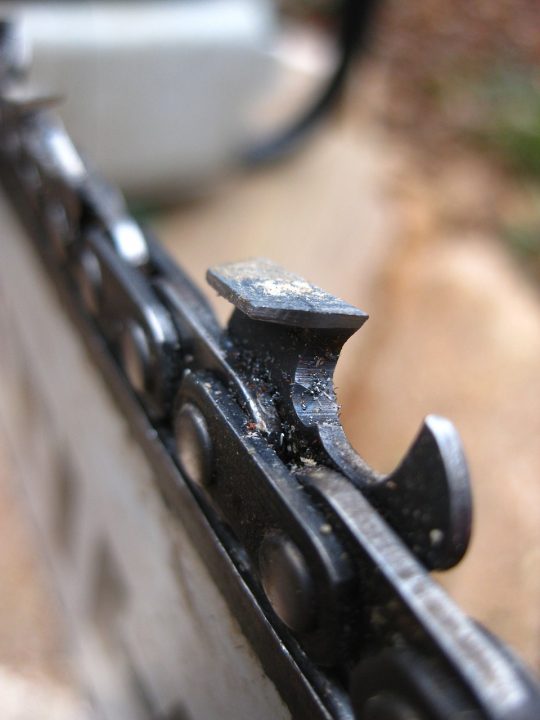
Be careful if it kickbacks because full chisel chains do not have the same safety features as other chains. The most frequent chainsaw-related injury is known as “chainsaw kickback“, which happens when the rotating blades abruptly stop after coming into contact with anything. The saw flies back toward the operator as a result.
When cutting unclean or softwood, which has a tendency to be more fibrous than porous, you shouldn’t use a full chisel chain. Although it is strong and excellent at chopping limbs or trees, you should constantly be on guard.
- Replacement Chainsaw Chain for Stihl Ms290, Husqvarna 450 Rancher, Husqvarna 435, Husqvarna 455 Rancher, Husqvarna 445, Husqvarna 440, Stihl 026, Husqvarna 45saw, Husqvarna 345, Stihl Ms310, Stihl Ms 271, Husqvarna 340, Husqvarna 350, Stihl 029, Husqvarna 450, Stihl Ms260, Husqvarna 455, Oregon D72, Husqvarna 55 Rancher, Husqvarna 55, Husqvarna 51, Stihl Ms 391, Husqvarna 460 Rancher, Stihl Ms390, Stihl Ms361, Poulan Pp5020av, Stihl Ms391, Stihl Ms 291, Husqvarna 359, Stihl Ms 311, Stihl Ms270
Prices pulled from the Amazon Product Advertising API on:
Product prices and availability are accurate as of the date/time indicated and are subject to change. Any price and availability information displayed on [relevant Amazon Site(s), as applicable] at the time of purchase will apply to the purchase of this product.
Semi-Chisel Cutters
Because the teeth on the semi-chisel chainsaw chain have rounded corners, you can identify it. The semi-chisel chain’s dependability is one of its best qualities. The semi-chisel cutters can handle all kinds of softwood despite operating at a reduced speed.
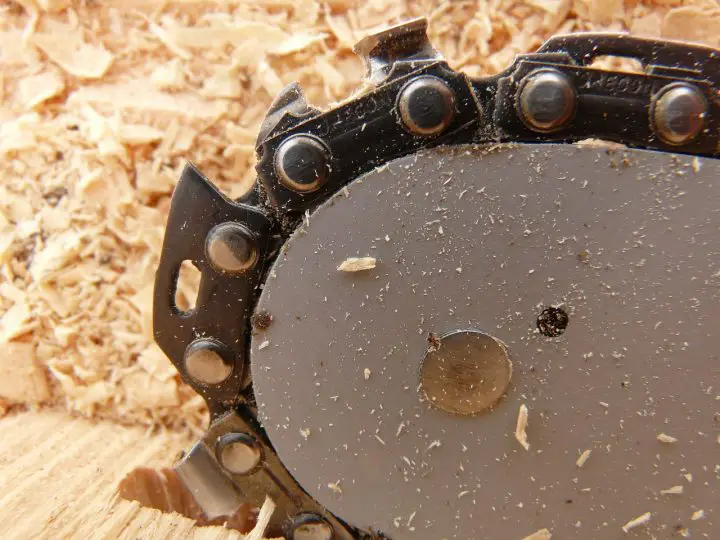
A semi-chisel chainsaw blade will prove to be more resilient and capable of cutting through soiled or frozen timber. Semi-chisel chains are more adaptable and safer than full-chisel chainsaw blades because they can reduce kickbacks. However, they do take a bit longer to complete tasks.
- 10-Inch chain fits Sun Joe models SWJ803E and SWJ807E pole chain saws
Prices pulled from the Amazon Product Advertising API on:
Product prices and availability are accurate as of the date/time indicated and are subject to change. Any price and availability information displayed on [relevant Amazon Site(s), as applicable] at the time of purchase will apply to the purchase of this product.
Chamfer Chisel Cutter
The performance of chamfer chisel chainsaw chains is comparable to that of a competent semi-chisel chainsaw chain. A slight 45-degree chamfer between the plates, as opposed to a radius, distinguishes a chamfered chisel chain from a semi-chisel chain.
The chamfer chainsaw chain cutters are intended to be used specifically by you to cut both hard, dry wood and green timber. The chamfer chisel chainsaw cutter has a smaller kick-back danger, similar to semi-chisel chainsaw chains.
- Advanced manufacturing materials, innovative product features, and extraordinary quality that maximizes the high value built into chainsaws
Prices pulled from the Amazon Product Advertising API on:
Product prices and availability are accurate as of the date/time indicated and are subject to change. Any price and availability information displayed on [relevant Amazon Site(s), as applicable] at the time of purchase will apply to the purchase of this product.
Square Chisel Cutters
Chainsaw blades with square chisels are only for pros. They require more frequent and precise filing than any other chain, which explains why. They are the fastest-cutting and most aggressive chainsaw chains available, but they can quickly become dull.
The edges and grind profiles of the square chisel cutters are square. They are renowned for being a specialized class of full-chisel professionals. Professionals precisely polish these chains back to their optimal performance using a chisel chin grinder.
- ✔️FULL CHISEL EFFICIENCY- NON safety chainsaw chain are for fast and experienced users. A full-chisel chainsaw blade provides the most efficient cutting - reliable replacement when your chain has a break or dulls
Prices pulled from the Amazon Product Advertising API on:
Product prices and availability are accurate as of the date/time indicated and are subject to change. Any price and availability information displayed on [relevant Amazon Site(s), as applicable] at the time of purchase will apply to the purchase of this product.
Chipper Cutter
The chipper chainsaw chains are another variation of the semi-chisel chain. The working corner of the chipper chainsaw chain cutters is significantly more rounded despite their similarity.
A semi-chisel design is more akin to the number “7,” with the top-right corner slightly rounded, than a chipper chain tooth, which has a full radius throughout the whole cutting region of the tooth and looks like a question mark.
Low-Profile Cutters
The most popular types of chainsaw chains available are low-profile chains. This is a result of both their high quality and extremely safe usage. In order to minimize chainsaw kickbacks, low-profile chainsaw chains are specifically created with safety features surrounding the teeth.
Although a low-profile chainsaw chain has some durability issues, it is nonetheless strongly advised for anyone who has never used a chainsaw before. A low-profile chainsaw chain is a fantastic choice if this is your first time using a chainsaw. Just be aware that sharpening might need to happen more frequently.
- Pitch: 3/8 Low Profile, gauge: .043, narrow kerf, drive link count: 52
Prices pulled from the Amazon Product Advertising API on:
Product prices and availability are accurate as of the date/time indicated and are subject to change. Any price and availability information displayed on [relevant Amazon Site(s), as applicable] at the time of purchase will apply to the purchase of this product.
Narrow Kerf Cutters
The thin kerf chainsaw chain will allow you to remove fewer logs. You obtain a thinner, more narrow cut because the entire chainsaw chain is slightly narrower than a regular chainsaw chain.
Because you are actually cutting through less wood with narrow kerf blades, your cuts will be quicker and require less power. In the end, you can get away with a longer bar since it cuts with less force. But keep in mind that a narrow kerf chainsaw chain requires a certain type of guide bar.
You can even get chains with low profiles and tiny kerfs for the lightest, fastest cut possible! These chains with a narrow kerf are typically sold under a name brand, such as the Pixel chain from Husqvarna, as presented in the pitch section further up the page.
- Manufactured with Patented Oregon OCS-01 steel which provides greater durability, especially in cold cutting conditions.The Blued Cutters provide superior corrosion resistance and improved strength.
Prices pulled from the Amazon Product Advertising API on:
Product prices and availability are accurate as of the date/time indicated and are subject to change. Any price and availability information displayed on [relevant Amazon Site(s), as applicable] at the time of purchase will apply to the purchase of this product.
Chainsaw Teeth Shapes
Cutter teeth are classified into two types: “round” and “square.” One features a circular or chipper-shaped cutting surface, while the other has a square or chisel-shaped cutting surface.
We can detect some similarities between them: both have been sharpened at an angle to simply and quickly cut through any material! However, if you look closely, you will notice that both have distinct angles, resulting in somewhat different cuts.
The first form is referred to as a Round/Chipper tooth. Chipper teeth are effective on large logs but not so much on small branches and twigs. The second type is the square tooth. It is an excellent tool for individuals who require something that can work with a variety of wood types. When used, it is slower than the round tooth, but it compensates for this with longevity and versatility.
Which Chainsaw Teeth are the Best?
You’ve heard the expression “you get what you pay for.” That is correct. The greatest chainsaw chain teeth are more expensive, but they perform better than cheaper ones due to their quality.
Low-quality blades can only last 20 cuts before dulling and will need to be sharpened frequently, however, high-grade steel can last up to 500 cuts and can’t even feel when sharpened, resulting in no wear on the chain or blade life!
The round cutter tooth chain produces the best cutting edge most of the time. This is because its edges are broader and better supported, as well as more durable than those on square teeth chains.
Because more steel is used in its production, it is easier to sharpen, keeps sharper for longer, and has a superior edge than other types of cutter teeth.
The square chain cutter teeth can be sharpened using a round file and cut around 15% faster, making them an easy-to-maintain solution for the ordinary user.
Round cutter tooth chains typically require more force to cut through wood fibers than sharp, square equivalents. Using a square tooth chain improves chainsaw cutting performance almost always.
Chain Arrangement
Let’s talk about the various chain arrangements now that you have familiarized yourself with the various chain kinds. Depending on the size of your chainsaw and the task you plan to use it for, these may operate differently. The possible change arrangements are:
- Full skip chain
- Semi-skip chain
- Full house chain (standard)
Full Skip Chain/Skip Tooth Chain
A skip tooth chain is another name for a full skip chainsaw chain. Because there are fewer teeth on the chain, they are wider and farther apart. The outcome is a chain that makes significant rough cuts in the wood. The full skip chainsaw chain arrangement is designed for anyone who wants to rapidly and effectively clear heavy timber with a blade of over 24 inches.
To use a full skip chain sequence, you will need a significantly larger chainsaw, preferably a 24-inch bar or greater. Due to the lack of teeth, skip tooth chains perform better with larger bars. Without enough teeth in the wood, a skip chain would rattle about a lot and make a messy cut if it were attached to a little bar. Furthermore, a skiptooth chain won’t deliver smooth cuts. It is designed to remove fallen trees and do the task quickly.
- Chainsaw Chain Specs - 18 Inch; 68 Drive Links; Pitch 3/8 Inch; Gauge .058; Full Chisel Skip Tooth Chain; Please verify fitment to ensure this part works with your machine
Prices pulled from the Amazon Product Advertising API on:
Product prices and availability are accurate as of the date/time indicated and are subject to change. Any price and availability information displayed on [relevant Amazon Site(s), as applicable] at the time of purchase will apply to the purchase of this product.
Semi-Skip Chain
Comparatively speaking, the semi-skip chainsaw chain has more teeth than the full-skip chain. In essence, it alternates between having a single tie strap and two tie straps between the two teeth. This arrangement offers more cutters than a standard skip chain while still allowing for the clearing of wood shavings from the cut.
The semi-skip chain, however, produces a cleaner cut. It is used by woodcutters for specific tasks, typically hard wood cutting with a chainsaw blade larger than 24″.
- Chainsaw Chain Specs - 28 Inch; 93 Drive Links; Pitch 3/8 Inch; Gauge .050 Inch; Full Chisel; Please verify fitment to ensure this part works with your machine
Prices pulled from the Amazon Product Advertising API on:
Product prices and availability are accurate as of the date/time indicated and are subject to change. Any price and availability information displayed on [relevant Amazon Site(s), as applicable] at the time of purchase will apply to the purchase of this product.
Full House or Standard Saw Chain
The chain of the full-house has the most teeth in its configuration. It can effortlessly chop through wood. All guide bars up to 24 inches long typically include a full-house chainsaw chain. The most typical application for these chain arrangements is the milling of lumber. This is due to the ability to create smooth boards.
- Cutter on every link of the chain
Prices pulled from the Amazon Product Advertising API on:
Product prices and availability are accurate as of the date/time indicated and are subject to change. Any price and availability information displayed on [relevant Amazon Site(s), as applicable] at the time of purchase will apply to the purchase of this product.
Cutter Material
The substance located at the cutters’ teeth or tips affects a chainsaw chain’s capacity to cut. Most chain saw chains are made of an alloy of steel. But after that, a substance that can significantly affect how well the chain cuts is applied on the chainsaw teeth. The often used tip cutters consist of:
- Chrome
- Tungsten carbide
- Diamond
Chrome Tipped
The majority of chain saw chains worldwide have chrome-tipped cutters. These are sturdy, appropriate for wood, and debris-resistant.
Tungsten Carbide Tipped
Chains with a tungsten carbide point are more resilient, last longer, and are best used in industrial settings. A carbide chainsaw chain can withstand far dirtier conditions than a standard chain. For wood that has been polluted with mud or soil, carbide chainsaw chains work excellently.
Chains with a tungsten carbide point are more resilient, last longer, and are best used in industrial settings. A carbide chainsaw chain can withstand far dirtier conditions than a standard chain. For wood that has been polluted with mud or soil, carbide chainsaw chains work excellently.
Diamond Tipped
You won’t need a diamond-tipped chainsaw in your backyard for actual rescue operations. The strongest chainsaw chain material available is this one! Concrete, metal, and rocks may all be cut with diamond chainsaw chains. In the event of a collision, they may easily cut through an automobile like butter. They are especially made for chainsaws made for concrete.
Interested in buying a chainsaw? Visit our buying guides:
FAQs (Frequently Asked Questions)
What are the different types of chains for a chainsaw?
Chainsaw chain types are typically described by their cutter style. The most popular four are full chisel, semi chisel, square chisel, and low profile chains, with each being used for different tasks.
What type of chainsaw chain is best?
Full chisel chainsaw chain are considered the best chain as they have squared, sharply pointed cutters that cut wood aggressively. They facilitate rapid passage of the chain through wood.
What type of chainsaw chain cuts the fastest?
Either a full chisel or a chisel skip chainsaw chain will cut wood more quickly. For chainsaw bars 24″ or less, the complete chisel gives the quickest and most vigorous cutting action. Pick a chisel skip chain for bars longer than 24″.
How do I know what chainsaw chain I have?
Your chain saw bar may have the information you are looking for labelled right on it. It will typically be found towards the back of the bar.










